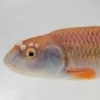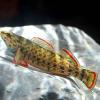Native classroom tank — ideas, feedback, and stocking
#1

Posted 19 June 2024 - 03:05 AM
I'm a new environmental science teacher in New Orleans, LA. I'm exploring the idea of starting a small small classroom biotope aquarium based on a cypress swamp. I've done some research, but I'm new to native fish/aquariums, so I'd love some feedback. I'd also love some help tracking down the fish I've picked out.
So, this year I plan to start with just a 10 gallon tank. I'm playing with the idea of turning this into an all-native aquaponic system later in the year, and will almost certainly upgrade the tank to 29 gallons within a year or two.
I'll probably go with a black, plantable substrate, add some cypress knees, probably a cave, a sponge filter, and plant some native aquatic plants. I'm looking at getting the following fish for the initial tank:
- Leptolucania ommata (Pygmy killifish) colony of 6-9+?
- Heterandria formosa (least livebearer/killifish) colony of 6-9+?
- Noturus gyrinus (tadpole madtom) just 1 if possible
- Cambarellus shufeldtii (Cajun dwarf crayfish) 5-10?
Questions:
- Are these critters likely to be okay together? They're all listed together on Jonah's Aquarium's compatibility chart, but I'd love your thoughts.
- Is 10 gallons (10.5" wide x 20.5" long x 12" high) too small for a tadpole madtom? I had a 6" kulhi loach in a 29 gallon tank once and it was definitely too small, but he was very active.
- If these fish do all work together, what numbers am I looking at for the two types of killifish if I want a near-full tank?
- How heavily planted should this tank be for fishy happiness and/or biotope accuracy? Esp keeping in mind that large water changes won't be a great option at school.
- I assume if/when I start the plants half of the aquaponic system that I'll want to increase the stock since the need for nutrients will increase... If biolode isn't an issue, how many fish can happily populate a 10 gallon and have enough space? Could any of the fish I'm interested in for the 29 gallon setup step in early? They include Etheostoma microperca (least darter), Elassoma zonatum (banded Pygmy sunfish), and Poecilia latipinna (sailfin molly).
When it comes to sourcing, Jonah's has the Heterandria formosa, and the Cajun dwarf crayfish is available from a few sources. However, I can't find anyone that seems to have Leptolucania ommata, and the only places that have Noturus gyrinus listed seem sketch. Any thoughts on where I could track these babies down once my tank is ready for fish? Or do you have suggestions for other fish that would match my biotope and be content in a 10 gallon?
Thanks all!
#2

Posted 22 June 2024 - 11:55 AM
OK, that's a lot of questions. I think I will answer a few and leave the others for those with different ideas.
First, I think your tank inhabitants are not too bad for your 10 gallon. Personally I am not a fan of nor do I trust crayfish of any type as my experience is that they are nocturnal predators, but if you like them, give it a try. One thing I think you should add is snails, and quite a few. These will mostly only eat dead and dying plant material, and are beneficial as supplemental food (both the adults and the eggs). I would start with 5 ommata and 3 of the Hets (you know that these are actually tiny live bearers, right). If all goes well you might get reproduction, so I would plant heavily and skip the cave idea. The young may still not survive the madtom but again it may still be worth it to have the mix of fishes (all community tanks are compromises).
I am no aquaponics expert, but I dont think you will need to increase your stocking level if you get good plant density in the 10 gallon.
I would consider that the pygmy sunfish will never really do well in a community tank and may need to be the sole occupants of another 10 gallon.
And I have never kept Sailfin Mollies but they are absolutely HUGE compared to your other fishes so I might leave them out of the mix all together. I also hear from some that they actually do better in different water condition than most of these other species.
#3

Posted 22 June 2024 - 11:56 AM
Oh, by the way, I love the idea of classroom aquariums and wish you the best of luck with whatever you try to do. I have helped a few folks with classroom or nature center aquariums and think they are absolute goldmines of education.
#4

Posted 24 June 2024 - 07:14 AM
Your current stock list will come with a lot a casualties, especially in a 10gal. You can do it, but I'd recommend a bigger tank. Predation is a part of life and gives you a new topic of discussion that may or may not be appropriate for your class (depending on age). However if you intend to start with a 10, I would do a species only tank. Mirroring Michaels sentiments, if done correctly, you can view, study, and discuss the entire lifecycle of Pygmy sunfish or Least killifish.
Crayfish usually always win, OR lose. (With most of those fish, they will fall prey to the claws. A tadpole madtom may be very inclined to consume small inverts like a pygmy crayfish). But again if kept alone, even they might breed and you can add sacrificial tankmates that you can replenish over time. A tank full of mollies would be enjoyable. But I'd get several once I had a larger tank for them. They will breed as long as you add water.
I think having a gameplan for routine water changes is important. I know it's not ideal for your school setup, but it is very beneficial and necessary for all of the living inhabitants of your tank--both fish and plant alike. Having a 10 gallon should make that process easy enough. Not trying to be insensitive here, but I wouldn't set up a tank and lead kids to believe that 'no water changes are needed if you have plants'. That is setting the stage for a lot of home fishtank setups that result in dead fish over the coming years. "But my teacher told me so!" I would go so far as to build in part of your lessons on the tank and its inhabitants, as to why water changes are important. I would not rely just on plants, although it is possible. In that case, fewer fish, more plants. But that's going down another path of discussion. Proper filtration (even just a sponge filter) and going over the nitrogen cycle with the students is fascinating and worth explaining.
We're all here, happy to discuss and help offer ideas. These are just a few of mine. Michaels comments are spot on, too.
Best of luck!
#5

Posted 25 August 2024 - 01:26 PM
Great topic! I'm interested in my own native classroom tank for environmental science as well, with heavy planting. I'm in Georgia though, and hoping to start with a 75g tank. My hope is for a lesser siren or multiple dwarf sirens to be a dominant feature of the tank, and I'm looking to see what other fish I could possibly include.
#6

Posted 11 September 2024 - 10:20 AM
Your fish should generally get along, but watch the tadpole madtom as it might get territorial in a 10-gallon. Consider upgrading to the 29-gallon sooner if possible. Start with a smaller group of killifish (6 each) and heavily plant the tank to mimic their natural habitat.
Reply to this topic
1 user(s) are reading this topic
0 members, 1 guests, 0 anonymous users











